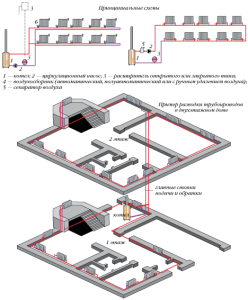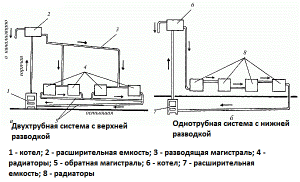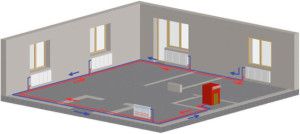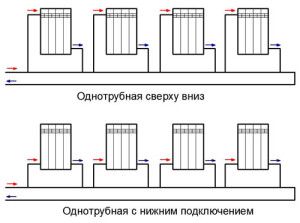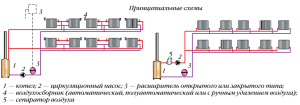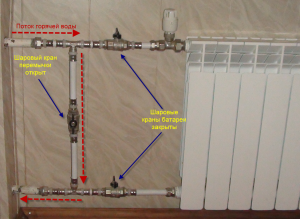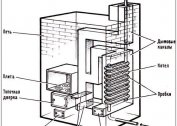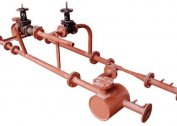The efficiency of heating is largely determined by correctly selected components - a boiler, pipes with an appropriate diameter, radiators and valves. However, in addition to this, you need to consider the location of the highway. What is the difference between a horizontal heating system: two-pipe, one-pipe, wiring and connection of heating devices? In order to determine the feasibility of designing and installing according to a similar scheme, you must first consider its specificity.
Feature of the horizontal pipe laying scheme
The vast majority of horizontal two-pipe heating system with lower wiring is installed in one or two-story private houses. But, besides this, it can be used to connect to central heating. A feature of such a system is the horizontal arrangement of the main and reverse (for two-pipe) mains.
When choosing this piping system, the nuances of connecting to various types of heating must be taken into account.
Central horizontal heating
To draw up an engineering scheme should be guided by the norms of SNiP 41-01-01-2003. It says that the horizontal wiring of the heating system should not only ensure proper circulation of the coolant, but also ensure its accounting. For this, two risers are equipped in apartment buildings - with hot water and for receiving cooled liquid. Be sure to calculate the horizontal two-pipe heating system, which includes the installation of a heat meter. It is installed on the inlet immediately after connecting the pipe to the riser.
In addition, the hydraulic resistance in certain sections of the highway is taken into account. This is important, since horizontal wiring of the heating system will only work effectively while maintaining the appropriate coolant pressure.
In most cases, for apartment buildings, a single-tube horizontal heating system with a lower wiring is installed. Therefore, when choosing the number of sections in radiators, it is necessary to take into account their remoteness from the central distribution riser. The further the battery is located, the larger should be its area.
Independent horizontal heating
In a private house or apartment without connecting to a central heating supply, the horizontal heating system with the lower wiring is most often chosen. However, it is necessary to take into account the operating mode - with natural circulation or forced under pressure. In the first case, a vertical riser is mounted directly from the boiler to which horizontal sections are connected.
The advantages of this arrangement arrangement to maintain a comfortable temperature level include the following:
- Minimum costs for the purchase of consumables. In particular, the horizontal one-pipe heating system with natural circulation does not include a circulation pump, a membrane expansion tank and protective fittings - air vents;
- Reliability of work. Since the pressure in the pipes is equal to atmospheric, the excess of the temperature regime is compensated by means of an expansion tank.
But also disadvantages should be noted. The main one is the inertia of the system.Even a well-designed horizontal one-pipe heating system of a two-story house with natural circulation will not be able to provide rapid heating of the premises. This is because the heating system begins to move only after reaching a certain temperature. For houses with a large area (from 150 sq. M.) And in the presence of two floors or more, a horizontal heating system with lower wiring and forced fluid circulation is recommended.
In contrast to the above scheme for forced circulation does not need to make a riser. The coolant pressure in a horizontal two-pipe heating system with a lower wiring is created using a circulation pump. This is reflected in improved performance:
- Fast distribution of hot water throughout the main;
- The ability to control the volume of coolant for each radiator (only for a two-pipe system);
- The installation requires a smaller area, since there is no distribution riser.
In turn, the horizontal wiring of the heating system can be combined with the collector. This is true for long-distance pipelines. Thus, it is possible to achieve an even distribution of hot water in all rooms of the house.
When calculating a horizontal two-pipe heating system, it is necessary to take into account the rotary nodes, it is in these places that the greatest hydraulic pressure losses are.
Single pipe horizontal heating system
What is a horizontal heating distribution in combination with a one-pipe system, in which cases can it be installed? Among specialists, it is considered the easiest to install and the most affordable. The principle of its design is that radiators are connected to the pipeline in series. Depending on the selected configuration, the connection of the nozzles may be upper or lower.
But at the same time, for a horizontal one-pipe heating system of a two-story house, the following disadvantages are characteristic:
- Uneven heat distribution over the batteries. The farther the radiator will be from the boiler, the lower will be the temperature of the water in it;
- Difficulties with the repair and maintenance work. When the radiator is disconnected from the general network in a horizontal single-pipe heating system with natural circulation, the flow of coolant further through the pipeline stops;
- The inability to control temperature in various rooms of the house.
During the design of this system, the installation of a bypass in front of each radiator is mandatory. In combination with shutoff valves, it will allow performing repair work or replacing individual heating elements.
For effective heat transfer, the batteries should be covered by a 2/3 window sill. This will contribute to optimal air convection in the room.
A single-pipe horizontal heating system with a lower wiring is installed only in houses with a small area - up to 150 sq.m. You also need to take care of additional thermal insulation of those rooms that are farthest from the boiler.
Two-pipe horizontal heating system
For a horizontal heating system with a lower wiring, all of the above disadvantages are absent. This is possible thanks to a different scheme for connecting radiators to pipelines. Each device is connected in parallel. The hot coolant flows through the tee assembly, and the cooled coolant flows directly into the return pipe.
Thus, it is possible to adjust the volume and speed of the coolant for each radiator. In addition, unlike a single-tube horizontal heating system with a lower wiring, an improved scheme has the following advantages:
- Installation of additional heating appliances will not affect the system. The main thing is that the boiler power allows you to heat the increased volume of coolant;
- Repair and maintenance work can be carried out without turning off the heating. To do this, it is enough to use the shutoff valves to shut off the coolant in the desired section of the network;
- If together with a horizontal two-pipe heating system with wiring from the bottom, distribution distributors are installed, efficiency can be increased, thereby minimizing energy costs.
The disadvantages of two-pipe heating with horizontal wiring include a greater likelihood of air congestion. To avoid this, a Mayevsky crane is installed on each radiator. With a large branched network, a calculation is made for a horizontal two-pipe heating system. It should include the size of the pressure drop in each section, as well as the change in water temperature. It is difficult to do this work on your own without proper skills, therefore it is best to use a professional online calculator, or resort to the help of specialists.
After the last most remote radiator, it is recommended that a manometer and air vent be installed. This set of measures will allow avoiding sharp pressure surges in the system and will make it possible to visually control its parameters.
Features of a complete set
During the installation of horizontal single pipe heating with natural circulation, the angle of inclination of the pipes must be observed. It runs towards the radiators in the direction of water movement. The lowest point of the return line must not be below the boiler level. It should be remembered that any horizontal wiring of heating is characterized by increased resistance - the larger the diameter of the pipe, the higher this indicator.
A two-pipe system must include a circulation pump and a membrane expansion tank. Without these elements, safe operation is not possible. Also installed measuring instruments - manometers and thermometers.
So which horizontal heating system to choose - two-pipe or single-pipe? This is determined by the characteristics of the house. For buildings with a large area, it is recommended to install a two-pipe wiring with forced circulation. If the speed of heating the air in the rooms and the ability to control the temperature are not important - you can mount one-pipe heating.
Calculation example for single pipe heating - hydraulic losses:
